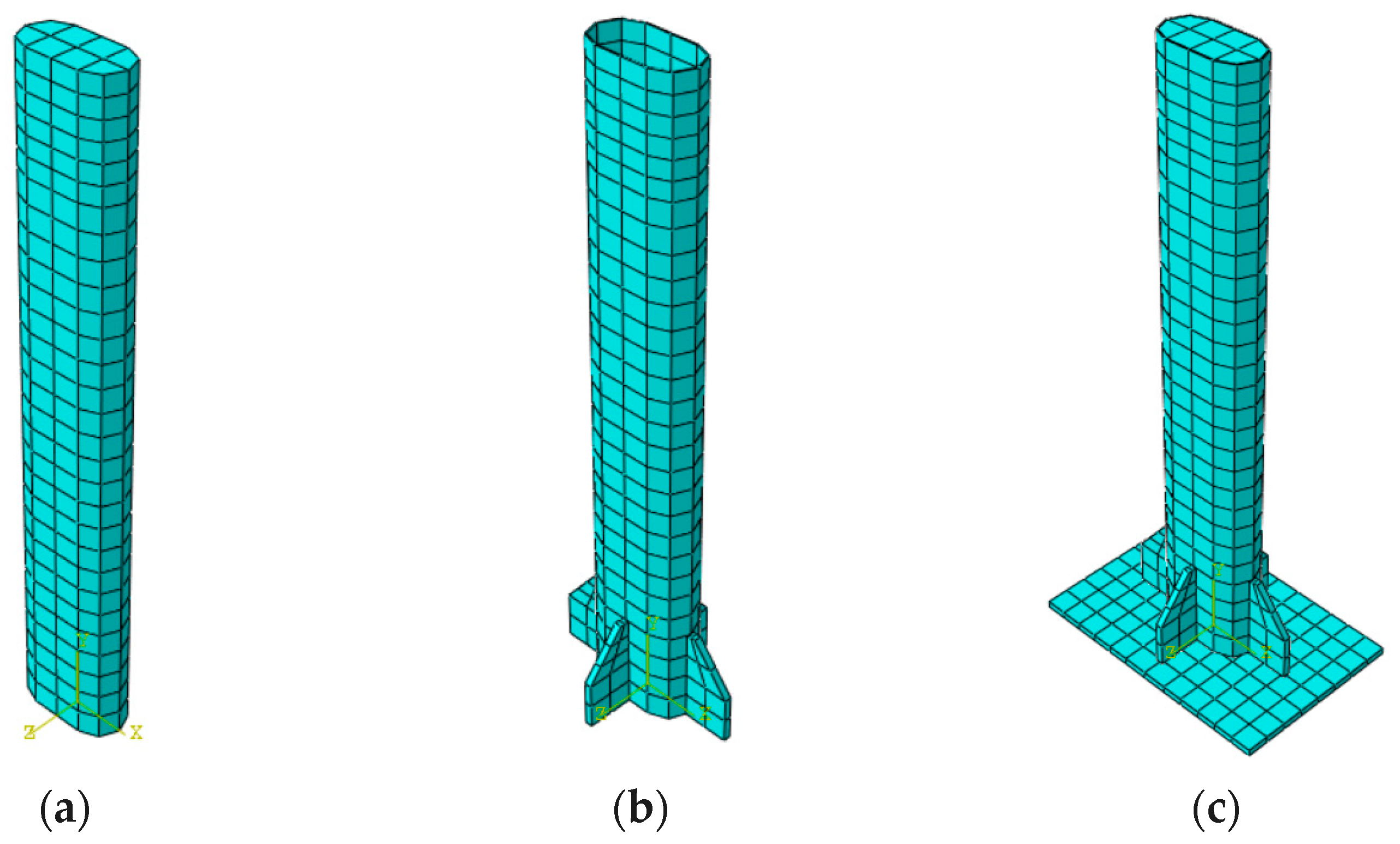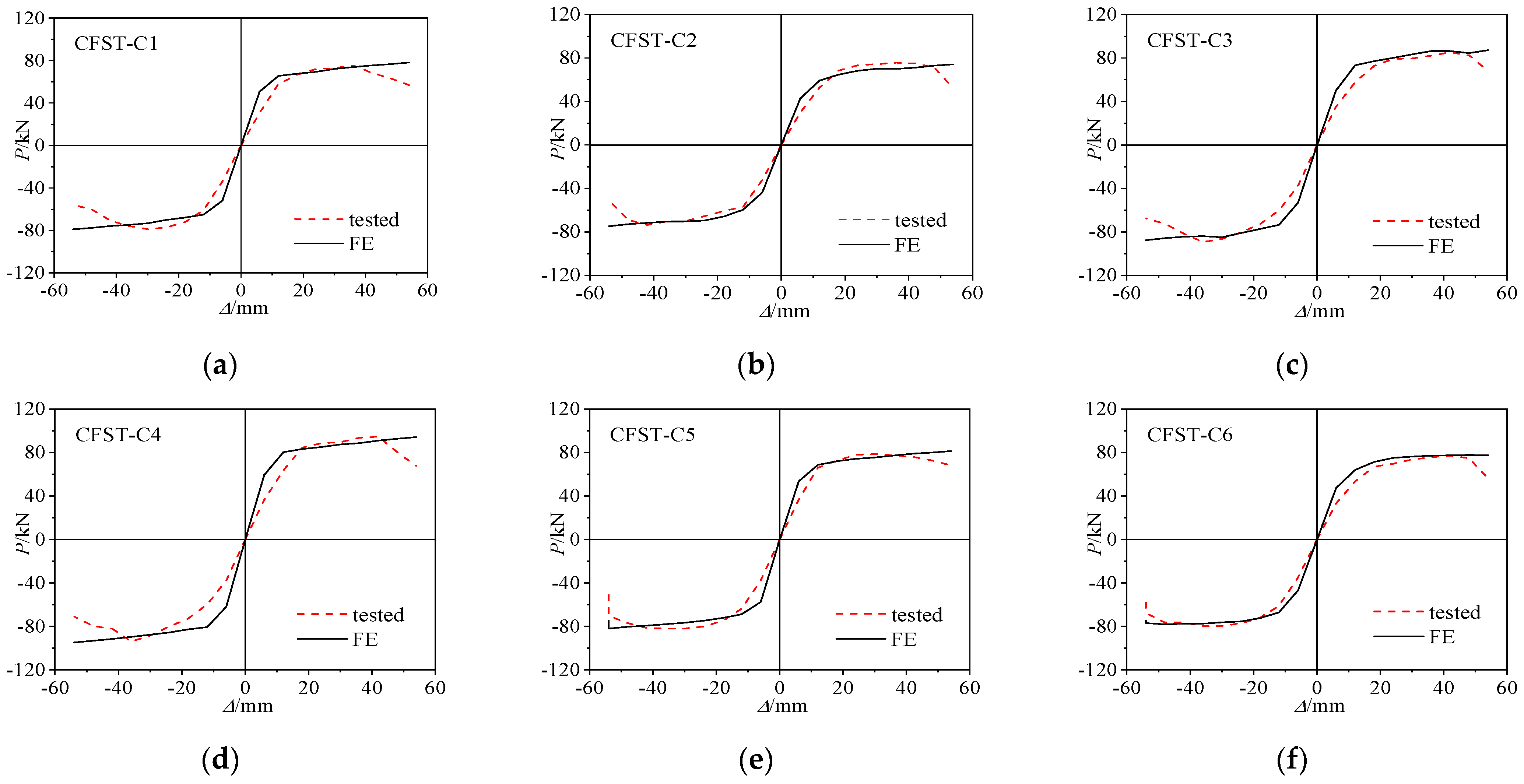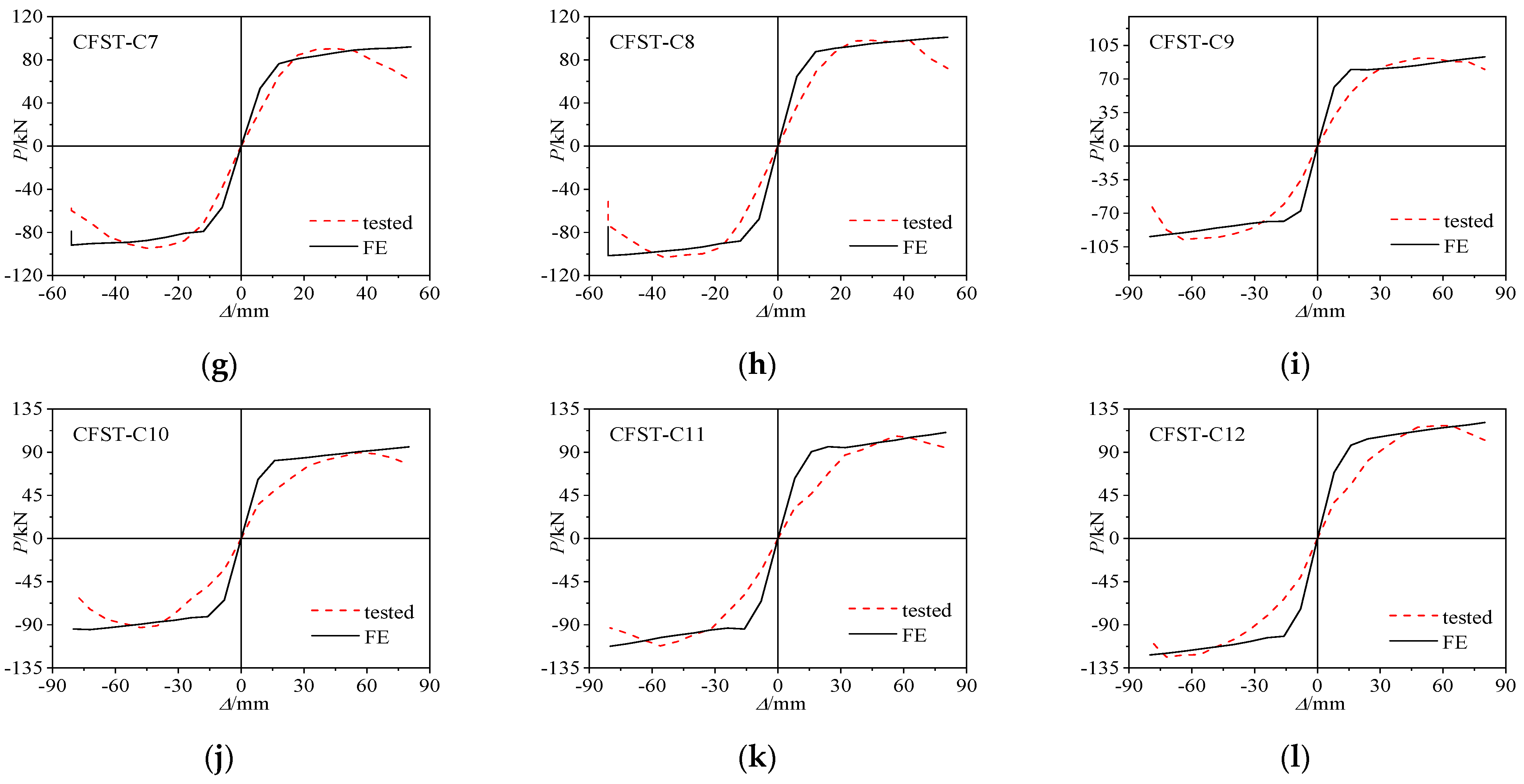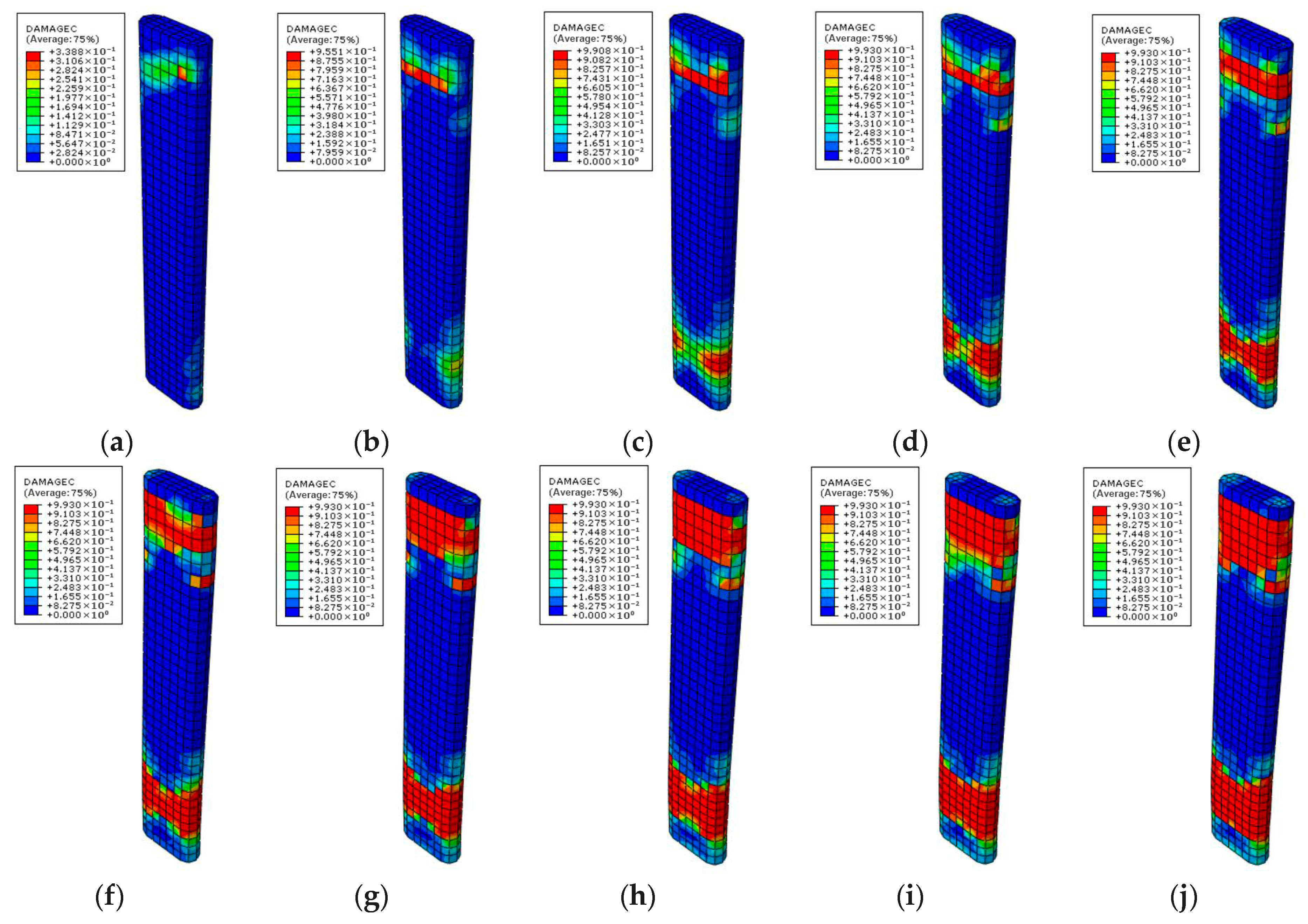Finite Element Analysis on the Seismic Performance of Concrete-Filled Steel Tube Columns with a Multiple-Chamber Round-Ended Cross-Section
Abstract
1. Introduction
2. Experimental Program
2.1. Specimen Information
2.2. Loading Scheme and Measuring Point Arrangement
3. Finite Element Model Establishment
3.1. FE Modeling
3.1.1. Material Constitutive Relation
3.1.2. Mesh and Element
3.2. Model Validation
3.2.1. Failure Mode
3.2.2. Hysteresis Curve
3.2.3. Skeleton Curve
3.2.4. Load–Strain Curve
- (1)
- Strain development during the loading procedure of the columns exhibits hysteretic characteristics. The surface of the steel tube experiences tensile strain (positive values) and compressive strain (negative values). The overall load–strain curve shows a relatively stable state, with considerable fluctuations in the later stages, which is related to the specimen’s failure, including the buckling damage in some measuring points of the steel tube during the experimental process.
- (2)
- Longitudinal and circumferential strains follow a roughly similar pattern. With the low-cycle reciprocating horizontal load, strains cyclically change in positive and negative directions; as the load continues to increase, the load–strain hysteresis curve becomes plumper. This result is due to the gradual increase in the steel tube’s constraint on the concrete during the later loading stages.
- (3)
- The steel tube undergoes small strain during the low-cycle reciprocating test at the straight-edge midpoint of the steel tube, which means that the steel tube’s constraint on the core concrete is relatively weak. The steel tube’s constraint on the core concrete is strong at the arc midpoint of the circular steel tube, and the steel tube undergoes large strain during the low-cycle reciprocating test.
3.2.5. Load–Steel Tube Surface Transverse Deformation Coefficient Curve
- (1)
- The measured data are relatively consistent with the FEA result. As the circumferential load increases, the circumferential stress of the steel tube also increases. The circumferential stress is greater than the axial stress, and the lateral deformation coefficient is greater than 0.5, revealing that the steel tube exerts a hoop restraint effect on the concrete.
- (2)
- In the early stages of cyclic loading, the rate of increase in circumferential strain is small, and the axial pressure is constant. Moreover, the longitudinal strain remains unchanged, leading to a relatively small lateral deformation coefficient in the early stages, maintaining a constant value. As the number of cyclic loading cycles increases, the localized deformation and circumferential strain of the steel tube increase, and the lateral deformation coefficient increases. When the cyclic loading reaches the last time, the transverse deformation coefficient increases sharply and reaches the maximum value.
4. Finite Element Analysis
4.1. Analysis of Damage and Stress Development in Steel Tube Concrete Columns
4.2. Plastic Energy Dissipation Analysis
- (1)
- Comparison of total plastic energy dissipation
- (2)
- Contribution of multi-chamber confinement to plastic energy dissipation
- (1)
- Concrete-filled steel columns with three chambers exhibit remarkably higher plastic energy dissipation values, with a relatively small difference between two-chamber and single-chamber configurations. The average increases for two chambers, three chambers, and four chambers compared with a single chamber are −3.9%, 11.6%, and 22.6%, respectively. Because the vertical partition of the two-chamber steel tube is near the neutral axis, it is difficult to exert a large plastic energy consumption, and the energy consumption increase is limited. However, the three-chamber specimen can give full play to the energy dissipation performance of the partition itself; thus, the overall energy consumption of the component increases greatly.
- (2)
- The increase or decrease in component plastic energy dissipation is primarily influenced by the steel material; from single-chamber to four-chamber configurations, the steel material energy consumption ratios are 0.97, 0.98, 0.98, and 0.98 on average, respectively. The energy dissipation performance of the component is enhanced by the increase in the steel content.
- (3)
- The proportion of concrete energy dissipation in the component is relatively small; from single-chamber to four-chamber configurations, the average steel material energy consumption ratios are 0.03, 0.02, 0.02, and 0.02, respectively. The multi-chamber confinement does not considerably alter the energy dissipation of concrete.
- (4)
- The axial pressure ratio has a considerable effect on the plastic energy dissipation of the component; under equivalent conditions, CFST-C5–CFST-C8 is 9.54% larger than CFST-C1–CFST-C4. This result is consistent with the experimental results, indicating that to a certain extent, increasing the axial pressure ratio of the specimen can enhance its seismic energy dissipation performance.
- (5)
- For M-CFST columns with a large length–width ratio, the chamber arrangement should bring the long and short sides closer together.
5. Conclusions
- (1)
- The FE model presented in this study can simulate the quasi-static behavior of CFST columns accurately. The calculated results are in good agreement with the measured values, as confirmed by verifying the factors of failure mode, load–displacement curves, and load–strain curves.
- (2)
- The FEA results illustrate that the maximum stress of the steel tube appears at the bottom in the arc region, which is consistent with the phenomenon of the steel tube bulging or even cracking. As shown in the compressive and tensile damage diagram of concrete, the concrete failure phenomenon at the bottom of the specimen is the most evident, which is consistent with the concrete failure after the test.
- (3)
- The energy dissipation of each column increases with the growth of analysis steps. The FEA results show that the steel material has the most important effect on plastic energy dissipation, and the proportion of concrete energy dissipation in the component is relatively small. FEA results indicate that as the axial pressure ratio increases, the contribution of multi-chamber confinement to enhancing the ultimate load-carrying capacity, ductility, and total plastic energy dissipation of multi-chamber confined circular steel tube concrete becomes more remarkable.
- (4)
- This study suggests that multi-chamber confinement can coordinate the work of the core concrete and the steel tube well. For circular steel tube concrete specimens with a large aspect ratio, the chambers must be arranged in a manner where the lengths of the long and short sides are closer.
- (5)
- The whole failure process and damage mechanism of the CFST columns under seismic loading at the microscale level deserve further research via a refined FEA model.
Author Contributions
Funding
Data Availability Statement
Conflicts of Interest
References
- Zhao, H.; Zhang, W.H.; Hou, C.C.; Lam, D. Axial compression behaviour of round-ended recycled aggregate concrete-filled steel tube stub columns (RE-RACFST): Experiment, numerical modeling and design. Eng. Struct. 2022, 276, 115376. [Google Scholar] [CrossRef]
- Wang, J.F.; Shen, Q.H. Numerical analysis and design of thin-walled RECFST stub columns under axial compression. Thin-Walled Struct. 2023, 129, 166–182. [Google Scholar] [CrossRef]
- Ding, F.X.; Fu, L.; Liu, X.M.; Liu, J. Mechanical performances of track-shaped rebar stiffened concrete-filled steel tubular (SCFRT) stub columns under axial compression. Thin-Walled Struct. 2016, 99, 168–181. [Google Scholar] [CrossRef]
- Wei, J.G.; Ying, H.D.; Yang, Y.; Zhang, W.; Bao, C.G. Experimental and numerical investigation of the seismic performance of concrete-filled steel tubular composite columns with UHPC plates. Structures 2023, 58, 105445. [Google Scholar] [CrossRef]
- Zhou, T.; Li, C.; Chen, Z.; Chen, H.; Guo, W.; Zhang, P. Quasi static behavior of specially shaped columns composed of concrete-filled steel tube frame-double steel concrete composite walls. J. Constr. Steel Res. 2021, 183, 106730. [Google Scholar] [CrossRef]
- Zhao, P.T.; Huang, Y.; Liu, Z.Z.; Liu, Y.Y.; Wang, H. Experimental study on seismic performance of hybrid steel-polypropylene fiber-reinforced recycled aggregate concrete-filled circular steel tube columns. Constr. Build. Mater. 2022, 359, 129413. [Google Scholar] [CrossRef]
- Xu, Q.Y.; Sun, H.; Ding, F.X.; Lyu, F. Analysis of ultimate seismic performance of thin-walled concrete-filled steel tube bridge piers under dynamic load. Eng. Struct. 2023, 292, 116544. [Google Scholar] [CrossRef]
- Chen, H.R.; Wang, L.; Chen, H.T.; Cui, W.B. Experimental study on the seismic behavior of prefabricated L-shaped concrete-filled steel tube with rectangular multi-cell columns under different lateral loading directions. J. Constr. Steel Res. 2021, 177, 106480. [Google Scholar] [CrossRef]
- Zhang, W.; Li, G.; Xiong, Q.Q.; Gui, H.W. Seismic behavior of wide-limb special-shaped columns composed of concrete-filled steel tubes. J. Constr. Steel Res. 2023, 205, 107887. [Google Scholar] [CrossRef]
- Liang, Y.M.; Shen, Q.H.; Wang, J.F.; Ma, X.F. Investigations on the seismic behaviour of concrete-filled thin-walled elliptical steel tubular column: Testing and novel FE modelling. Thin-Walled Struct. 2023, 191, 111029. [Google Scholar] [CrossRef]
- Han, L.-H. Concrete Filled Steel Tubular Structures-Theory and Practice; Sicence Press: Beijing, China, 2016. [Google Scholar]
- Sun, H.; Ci, M.; Zheng, B.; Yang, H.; Wang, W.; Wang, S. Seismic behavior and mechanism of rectangular steel-concrete composite column with three cavities. J. Constr. Steel Res. 2023, 212, 108299. [Google Scholar] [CrossRef]
- Wang, Y.H.; Guo, L.H.; Li, H.D.; Shafaei, S.; Yu, Y. Lateral load response of L-shaped steel–concrete composite shear walls using multi-partition steel tube. Eng. Struct. 2023, 293, 116671. [Google Scholar] [CrossRef]
- Liu, W.H.; Guo, Y.L.; Tian, Z.H.; Yang, X.; Li, J.Y. Experimental and numerical study of T-shaped irregularly concrete-filled steel tube columns under combined axial loads and moments. J. Build. Eng. 2023, 65, 105796. [Google Scholar] [CrossRef]
- Guo, Z.; Chen, Y.; Wang, Y.; Jiang, M.Y. Experimental study on square concrete-filled double skin steel tubular short columns. Thin-Walled Struct. 2020, 156, 107017. [Google Scholar] [CrossRef]
- Wu, H.P.; Han, X.D.; Meng, C.; Wang, X.M.; Gan, D.; Shen, Z.H. United composite strength calculation method for special-shaped CFST columns with multiple cavities. Structures 2023, 58, 105491. [Google Scholar] [CrossRef]
- Cheng, R.; Hu, C.; Gong, M.L.; Wang, Y.H. Behaviors of improved multi-cell T-shaped concrete-filled steel tubular columns under eccentric loads. J. Constr. Steel Res. 2022, 193, 107251. [Google Scholar] [CrossRef]
- Liu, J.; Yu, W.Z.; Fang, Y.W.; Pan, Z. Experimental study on the seismic performance of concrete-filled steel tube columns with a multiple-chamber round-ended cross-section. Front. Mater. 2024, 11, 1363206. [Google Scholar] [CrossRef]
- JGJ/T 101-2015; Specification for Seismic Test of Buildings. Architecture and Building Press: Beijing, China, 2015.
- Ding, F.X.; Yin, G.A.; Wang, L.P.; Hu, D.; Chen, G.Q. Seismic performance of a non-through-core concrete between concrete-filled steel tubular columns and reinforced concrete beams. Thin-Walled Struct. 2017, 110, 14–26. [Google Scholar] [CrossRef]
- Ding, F.X.; Ying, X.Y.; Zhou, L.C.; Yu, Z.W. Unified calculation method and its application in determining the uniaxial mechanical properties of concrete. Front. Archit. Civ. Eng. China 2011, 5, 381. [Google Scholar] [CrossRef]
















| No. | Specimen | B × D × t × H/mm | Chamber Arrangement | n | fs | fcu | ρs |
|---|---|---|---|---|---|---|---|
| 1 | CFST-C1 | 228 × 114 × 3 × 1150 | Single chamber | 0.1 | 359 | 45.2 | 7.58 |
| 2 | CFST-C2 | 228 × 114 × 3 × 1150 | Two chambers | 0.1 | 359 | 45.2 | 9.05 |
| 3 | CFST-C3 | 228 × 114 × 3 × 1150 | Three chambers | 0.1 | 359 | 45.2 | 10.53 |
| 0.3 | |||||||
| 0.1 | |||||||
| 0.3 | |||||||
| 4 | CFST-C4 | 228 × 114 × 3 × 1150 | Four chambers | 0.1 | 359 | 45.2 | 12.00 |
| 5 | CFST-C5 | 228 × 114 × 3 × 1150 | Single chamber | 0.3 | 359 | 45.2 | 7.58 |
| 6 | CFST-C6 | 228 × 114 × 3 × 1150 | Two chambers | 0.3 | 359 | 45.2 | 9.05 |
| 7 | CFST-C7 | 228 × 114 × 3 × 1150 | Three chambers | 0.3 | 359 | 45.2 | 10.53 |
| 8 | CFST-C8 | 228 × 114 × 3 × 1150 | Four chambers | 0.3 | 359 | 45.2 | 12.00 |
| 9 | CFST-C9 | 342 × 114 × 3 × 1650 | Single chamber | 0.1 | 359 | 45.2 | 6.75 |
| 10 | CFST-C10 | 342 × 114 × 3 × 1650 | Two chambers | 0.1 | 359 | 45.2 | 7.69 |
| 11 | CFST-C11 | 342 × 114 × 3 × 1650 | Three chambers | 0.1 | 359 | 45.2 | 8.64 |
| 12 | CFST-C12 | 342 × 114 × 3 × 1650 | Four chambers | 0.1 | 359 | 45.2 | 10.53 |
| No. | Cyclic Maximum Displacement | Maximum Value of Concrete Compression Damage | Maximum Value of Concrete Tensile Damage | Maximum Value of Steel Stress/MPa |
|---|---|---|---|---|
| 1 | 8 mm | 0.339 | 0.992 | 364.0 |
| 2 | 16 mm | 0.955 | 0.992 | 389.8 |
| 3 | 24 mm | 0.991 | 0.992 | 423.9 |
| 4 | 32 mm | 0.993 | 0.992 | 422.6 |
| 5 | 40 mm | 0.993 | 0.992 | 455.2 |
| 6 | 48 mm | 0.993 | 0.992 | 467.0 |
| 7 | 56 mm | 0.993 | 0.992 | 485.7 |
| 8 | 64 mm | 0.993 | 0.992 | 491.6 |
| 9 | 72 mm | 0.993 | 0.992 | 495.6 |
| 10 | 80 mm | 0.993 | 0.992 | 504.8 |
| No. | Specimen | Chamber Arrangement | Axial Compression Ratio | Concrete (kJ) | Steel (kJ) | ALL (kJ) |
|---|---|---|---|---|---|---|
| 1 | CFST-C1 | Single chamber | 0.1 | 1.12 | 40.07 | 41.19 |
| 2 | CFST-C2 | Two chambers | 0.1 | 0.79 | 37.32 | 38.11 |
| 3 | CFST-C3 | Three chambers | 0.1 | 1.03 | 45.10 | 46.13 |
| 4 | CFST-C4 | Four chambers | 0.1 | 0.90 | 49.73 | 50.63 |
| 5 | CFST-C5 | Single chamber | 0.3 | 1.42 | 42.95 | 44.37 |
| 6 | CFST-C6 | Two chambers | 0.3 | 1.14 | 41.96 | 43.10 |
| 7 | CFST-C7 | Three chambers | 0.3 | 1.40 | 48.17 | 49.57 |
| 8 | CFST-C8 | Four chambers | 0.3 | 1.03 | 54.79 | 55.82 |
| 9 | CFST-C9 | Single chamber | 0.1 | 2.37 | 84.19 | 86.56 |
| 10 | CFST-C10 | Two chambers | 0.1 | 2.14 | 83.35 | 85.49 |
| 11 | CFST-C11 | Three chambers | 0.1 | 2.30 | 93.76 | 96.06 |
| 12 | CFST-C12 | Four chambers | 0.1 | 1.86 | 101.20 | 103.05 |
Disclaimer/Publisher’s Note: The statements, opinions and data contained in all publications are solely those of the individual author(s) and contributor(s) and not of MDPI and/or the editor(s). MDPI and/or the editor(s) disclaim responsibility for any injury to people or property resulting from any ideas, methods, instructions or products referred to in the content. |
© 2024 by the authors. Licensee MDPI, Basel, Switzerland. This article is an open access article distributed under the terms and conditions of the Creative Commons Attribution (CC BY) license (https://creativecommons.org/licenses/by/4.0/).
Share and Cite
Liu, J.; Yu, W.; Fang, Y.; Pan, Z.; Cao, G. Finite Element Analysis on the Seismic Performance of Concrete-Filled Steel Tube Columns with a Multiple-Chamber Round-Ended Cross-Section. Buildings 2024, 14, 1154. https://doi.org/10.3390/buildings14041154
Liu J, Yu W, Fang Y, Pan Z, Cao G. Finite Element Analysis on the Seismic Performance of Concrete-Filled Steel Tube Columns with a Multiple-Chamber Round-Ended Cross-Section. Buildings. 2024; 14(4):1154. https://doi.org/10.3390/buildings14041154
Chicago/Turabian StyleLiu, Jing, Wenzhuo Yu, Yawei Fang, Zimao Pan, and Guohui Cao. 2024. "Finite Element Analysis on the Seismic Performance of Concrete-Filled Steel Tube Columns with a Multiple-Chamber Round-Ended Cross-Section" Buildings 14, no. 4: 1154. https://doi.org/10.3390/buildings14041154
APA StyleLiu, J., Yu, W., Fang, Y., Pan, Z., & Cao, G. (2024). Finite Element Analysis on the Seismic Performance of Concrete-Filled Steel Tube Columns with a Multiple-Chamber Round-Ended Cross-Section. Buildings, 14(4), 1154. https://doi.org/10.3390/buildings14041154







